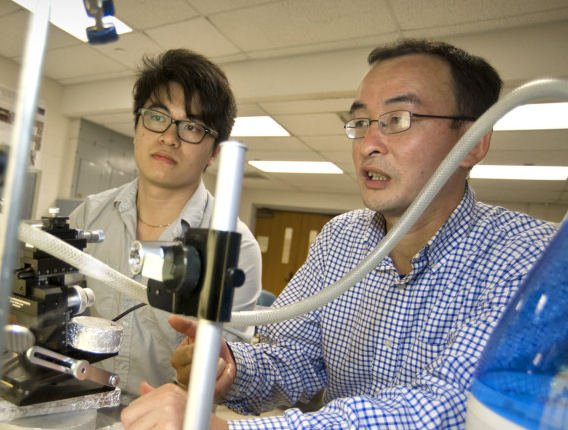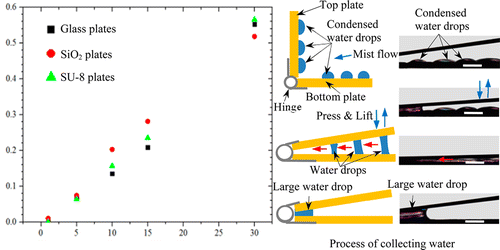A UT
Arlington engineering professor and his doctoral student have
designed a device based on a shorebird's beak that can
accumulate water collected from fog and dew.
The device could provide water in drought-stricken areas of the
world or deserts around the globe.
Xin Heng, left, a doctoral student in Mechanical and Aerospace
Engineering, and Cheng Luo, MAE professor, have made a device
that can use fog and dew to collect water.
Cheng Luo, professor in the Mechanical & Aerospace
Engineering Department, and Xin Heng, PhD candidate in the same
College of Engineering department, published "Bioinspired
Plate-Based Fog Collectors" in the Aug. 25 edition of ACS'
(American Chemical Society) Applied Materials & Interfaces
journal.
The idea began when Heng saw an article that explained the
physical mechanism shorebirds use to collect their food --
driving food sources into their throats by opening and closing
their beaks. Luo said that inspired the team to try to replicate
the natural beak in the lab.
"We wanted to see if we could do that first," Luo said. "When we
made the artificial beaks, we saw that multiple water drops were
transported by narrow, beak-like glass plates. That made us
think of whether we could harvest the water from fog and dew."
Their experiments were successful. They found out they could
harvest about four tablespoons of water in a couple of hours
from glass plates that were about 26 centimeters long by 10
centimeters wide.
Shorebirds refers to a general category of bird that lives on
the world's shorelines. They typically have long, hinged beaks
that are designed to ferret around for prey whether in the sand
or the water.
Luo said the hinged, non-parallel artificial beaks the team made
in the lab mimic the shorebirds' beaks, forcing the condensation
to the point where the two glass plates meet. The water is
pumped through a channel, and then the process is repeated.
Luo and Heng said more sustainable methods are needed for
accumulating water in arid or semi-arid places, which make up
about half of the world's land mass.
"And really, if this method could be mass-produced, it could be
used anywhere in the world fog or dew exist," Luo said.
Khosrow Behbehani, dean of the College of Engineering, said the
research could help drought-stricken areas like Texas and
California.
"The research shows innovative ideas can be triggered by careful
observation of seemingly unrelated phenomenon," Behbehani said.
"Collecting water from existing fog or dew using this novel
method offers another alternative for communities that are
strapped for our most precious resource."
http://www.uta.edu/news/releases/2014/09/birdbeak-water-luo.php
http://pubs.acs.org/doi/abs/10.1021/am504457f
ACS Applied Materials & Interfaces, 2014;
140905134259007
Bioinspired
Plate-Based Fog Collectors
Xin Heng and Cheng
Luo
Abstract -- In a recent work, we explored the
feeding mechanism of a shorebird to transport liquid drops by
repeatedly opening and closing its beak. In this work, we apply
the corresponding results to develop a new artificial fog
collector. The collector includes two nonparallel plates. It has
three advantages in comparison with existing artificial
collectors: (i) easy fabrication, (ii) simple design to scale
up, and (iii) active transport of condensed water drops. Two
collectors have been built. A small one with dimensions of 4.2 ×
2.1 × 0.05 cm3 (length × width × thickness) was first built and
tested to examine (i) the time evolution of condensed drop sizes
and (ii) the collection processes and efficiencies on the glass,
SiO2, and SU-8 plates. Under similar experimental conditions,
the amount of water collected per unit area on the small
collector is about 9.0, 4.7, and 3.7 times, respectively, as
much as the ones reported for beetles, grasses, and metal wires,
and the total amount of water collected is around 33, 18, and 15
times. On the basis of the understanding gained from the tests
on the small collector, a large collector with dimensions of 26
× 10 × 0.2 cm3 was further built and tested, which was capable
of collecting 15.8 mL of water during a period of 36 min. The
amount of water collected, when it is scaled from 36 to 120 min,
is about 878, 479, or 405 times more than what was collected by
individual beetles, grasses, or metal wires.


